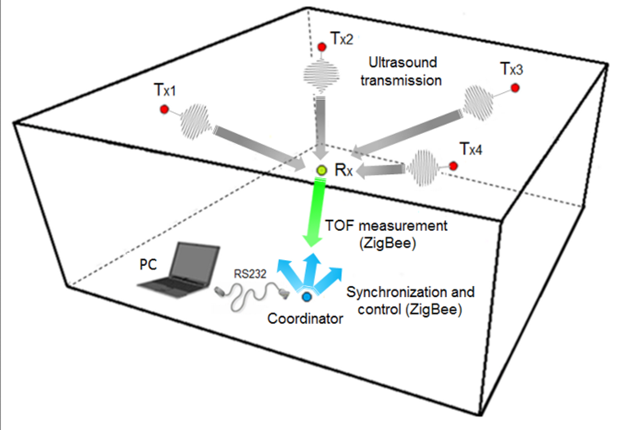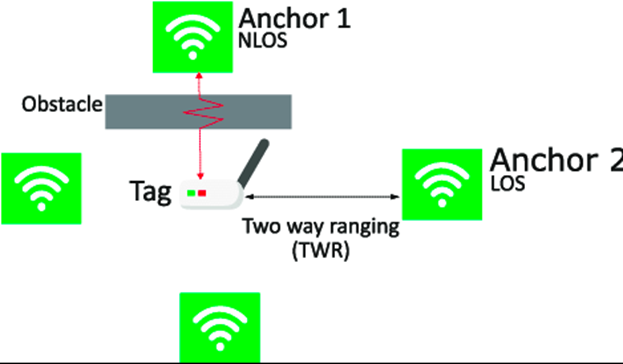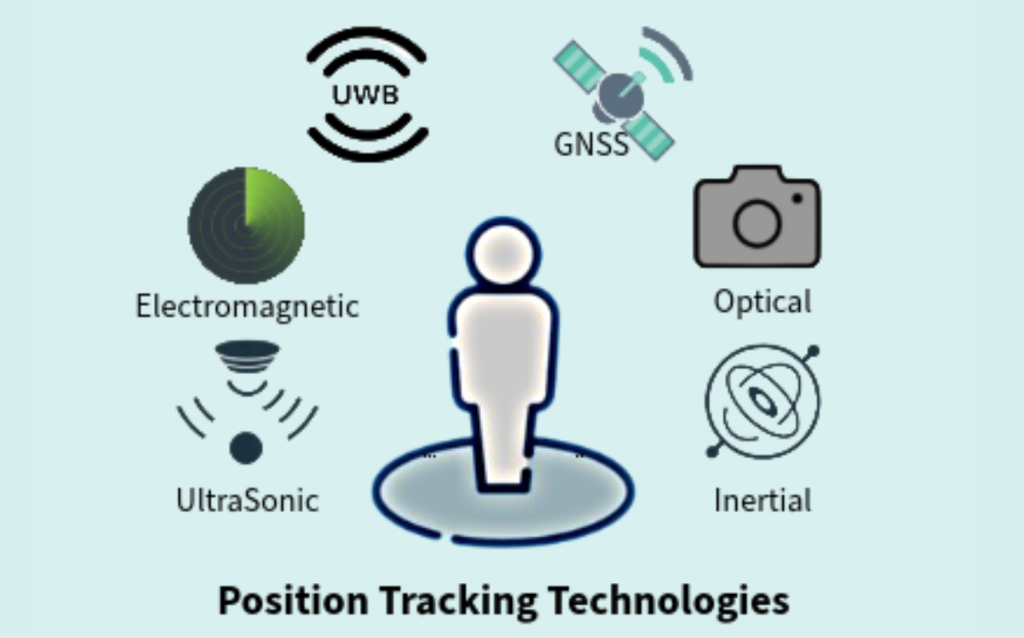Choosing the right position/motion tracking technology is necessary for the success of any product that requires tracking the location of objects or individuals. Position tracking technologies have revolutionized numerous industries, from virtual reality and film production to healthcare and sports analytics. This article compares various real-time position tracking technologies, focusing on their operational principles, applications, advantages, and disadvantages.

Source: awn
Table of Content
Toggle1. Electromagnetic Tracking Systems
Electromagnetic tracking systems operate by generating a magnetic field from a transmitter. The sensors, which act as receivers, detect the magnetic field at various orientations and positions, allowing the system to calculate their exact location in real-time relative to the transmitter.
The setup is moderately complex due to the need for careful positioning and calibration to avoid environmental interference.

Source: ndigital (1. Sensor, 2. Field Generator, 6. Output Screen)
Technical Components:
- Transmitter: Emits a low-frequency electromagnetic field.
- Sensors: Typically small, sensitive devices that detect the magnetic field’s strength and direction.
- Signal Processing Unit: Analyzes data from the sensors to determine position and orientation based on the known characteristics of the emitted field.
Typical Applications:
- Medical: Widely used in surgical navigation systems to track instruments without direct line of sight, crucial for minimally invasive procedures.
- Virtual Reality: Enhances immersive experiences by accurately tracking the position and orientation of VR devices.
Key Features and Advantages:
- High Accuracy: Can achieve millimeter-level positional accuracy and low latency.
- No Line-of-Sight Requirement: Unlike optical systems, electromagnetic trackers do not require a line of sight between the transmitter and receiver.
Technical Challenges and Limitations:
- Susceptibility to Interference: Metallic objects, and electronic equipment can distort the magnetic field, affecting accuracy.
- Limited Range: The effective range is generally limited by the strength and reach of the electromagnetic field.
2. Optical Tracking Systems
Optical tracking systems utilize cameras to capture the position of visible or infrared markers attached to objects. These systems calculate the three-dimensional location of these markers by analyzing the images captured from multiple angles, using techniques such as stereoscopic vision.
The setup is highly complex, as it requires camera calibration and optimal lighting arrangement.

Source: ndigital (1. Sensor/Instrument, 2. IR Sensor, 3. IR Markers, 4. IR Sensor Head, 5. Needle, 6. Output Screen)
Technical Components:
- Cameras: Capture real-time imagery of the tracking area; can be specialized infrared or standard video cameras.
- Markers: Reflective or LED markers that are tracked by the cameras.
- Processing Unit: Computes the position data from the camera feeds, often using triangulation methods.
Typical Applications:
- Motion Capture in Film and Gaming: Used extensively to capture detailed human movements for CGI effects in movies and video games.
- Sports Biomechanics: Analyzes athletes’ movements to enhance performance and prevent injuries.
Key Features and Advantages:
- High Precision and Resolution: Provides sub-millimeter spatial resolution and accuracy.
- Scalability: Can scale the tracking area by adding more cameras.
Technical Challenges and Limitations:
- Line-of-Sight Requirement: Obstructions between the camera and the markers leads to loss of tracking.
- Complex Setup and Calibration: Requires precise calibration and setup for accurate tracking.
3. Inertial Tracking Systems
Inertial tracking systems use accelerometers and gyroscopes to measure linear accelerations and angular velocities. These data points are integrated over time to determine an object’s position and orientation from its starting point.
Inertial tracking system doesn’t need additional components (such as anchors or additional reference points) but it requires careful calibration of the sensors to ensure accuracy. In case of absolute position tracking, it also requires other reference tracking systems (such as GPS) to correct for the drift.

Source: diyengineers
Technical Components:
- Accelerometers: Measure acceleration in the device’s coordinate system.
- Gyroscopes: Detect rotational movements around the axes.
- Processing Unit: Integrates the sensor data to derive motion and orientation.
Typical Applications:
- Consumer Electronics: Used in smartphones and tablets for screen orientation and motion detection.
- Vehicle Navigation: Assists in determining vehicle movement where GPS is unavailable.
- Sports and Health: Monitors athletes’ movements and patients’ physical therapy progress.
Key Features and Advantages:
- Self-contained: Does not rely on external references (mostly), making it highly portable.
- Effective in Occluded Environments: Works well where optical systems fail due to line-of-sight issues
Technical Challenges and Limitations:
- Drift Errors: Integration of acceleration and angular rates can accumulate errors over time, leading to drift of several degrees per minute.
- Limited Absolute Positioning: Primarily provides relative motion data, which may need to be supplemented with other technologies for positional accuracy.
4. Ultrasonic Tracking Systems
Ultrasonic tracking systems detect objects using high-frequency sound waves. It emits ultrasonic pulses, and sensors capture the echoes that bounce back from objects. The time it takes for these echoes to return helps calculate the distance to the objects.
Setting up these systems involves moderate complexity due to the need for precise calibration to account for environmental factors.

Technical Components:
- Transmitters: Emit ultrasonic waves.
- Receivers: Capture the reflected ultrasonic waves.
- Processing Unit: Calculates distances from the time delay of the returning waves.
Typical Applications:
- Robotics: Navigational aid for obstacle avoidance and path planning.
- Medical Field: Used in certain diagnostic imaging techniques to map body structures.
Key Features and Advantages:
- Cost-effective: Generally cheaper than optical and electromagnetic systems.
- Non-Visual Tracking: Operates effectively without the need for visual markers or light.
- Versatile Material Detection: Can detect various materials, including soft fabrics and liquids.
Technical Challenges and Limitations:
- Lower Accuracy and Resolution: Typically offers accuracy within a range of several centimeters, less precise than optical and electromagnetic systems.
- Environmental Sensitivity: Performance can be affected by changes in air temperature and humidity.
5. Capacitive Tracking Systems
Capacitive tracking systems measure the capacitance change induced by the proximity or touch of a conductive object, typically a human finger. These systems utilize electrodes to generate an electric field, detecting disturbances caused by touching or approaching the surface. Sensors are embedded within the surfaces of devices or panels where interaction will occur.
These systems require sensors to be embedded in devices or surfaces. Sensitivity adjustments might be necessary depending on the installation environment, which can make the setup complex.

Source: makezine
Technical Components:
- Sensors: Embedded in the screen or device surface, these detect changes in the electrical field.
- Controller: Processes the signal from the sensors to determine the location and nature of the touch.
Typical Applications:
- Smartphones and Tablets: Provides touch interface for user interaction.
- Interactive Kiosks and Displays: Used in public information display and interactive installations.
Key Features and Advantages:
- Touchless Interaction: Can detect gestures and movements without direct contact.
- High Sensitivity: Responds to light touches, enabling precise interactions.
- Multi-Touch Capability: Can detect and process multiple touches simultaneously.
Technical Challenges and Limitations:
- Material Sensitivity: Performance can be influenced by the materials used in the cover lens; metal surfaces can interfere with signal detection.
- Environmental Factors: Performance can degrade with moisture or the presence of other conductive substances.
6. Ultra-Wideband (UWB) Technology
Ultra-Wideband (UWB) technology is known for its ability to perform precise indoor positioning and distance measurement with cm-level accuracy. UWB operates by transmitting extremely short pulses over a wide frequency spectrum, which allows for high-resolution ranging and robustness against signal interference and multipath effects.
Installing Ultra-Wideband (UWB) technology involves placing UWB transmitters and receivers, known as anchors and tags, throughout the tracking environment. The setup requires strategic anchor placement to ensure comprehensive area coverage and optimal precision, which makes the installation complex.

Technical Components:
- Anchors: Fixed UWB transmitters installed at known locations within the environment.
- Tags: Mobile UWB receivers that communicate with anchors to determine their position.
- Processing Unit: Collects and processes signal data from the tags and anchors to calculate precise locations.
Applications:
- Industrial Automation: Used for asset tracking and managing logistics in complex industrial settings.
- Smart Homes, Sports and IoT: Enhances automation by precisely locating and interacting with various smart devices within the home. Precise tracking of sports players.
Key Features and Advantages:
- High Accuracy: Delivers positioning accuracy up to centimeter-level, making it ideal for applications requiring precise location tracking.
- Robust in Dense Environments: Performs well in environments with physical obstructions where other RF technologies might fail.
Technical Challenges and Limitations:
- Setup Sensitivity: The effectiveness of UWB can be dependent on the physical layout of the environment and requires careful planning of anchor locations.
- Cost: UWB technology can be more expensive compared to other RF technologies due to the hardware and installation requirements.
7. Bluetooth Low Energy (BLE) Tracking Systems
Bluetooth Low Energy (BLE) technology is widely used for proximity sensing and indoor positioning with a typical accuracy level within a few meters, making it especially suitable for applications that require moderate precision over short distances.
BLE tracking involves placing beacons at intervals to effectively cover the tracking area. This setup is simpler and less demanding than UWB, which requires precise anchor placement and extensive calibration for higher accuracy. BLE’s straightforward beacon deployment makes it suitable for quick implementation in various environments.

Source: spaces cisco
Technical Components:
- Beacons: Small devices that emit BLE signals at predefined intervals.
- Receivers: Devices that pick-up signals from beacons, often smartphones or dedicated BLE receivers.
- Processing Unit: Analyzes signal strength and timing from multiple beacons to determine position.
Applications:
- Retail: Enables in-store analytics and personalized advertising by tracking consumer movements within a store.
- Healthcare: Monitors patient movements and staff within a hospital setting.
- Event Management: Tracks attendee movements at conferences or large-scale events for security and crowd management.
Key Features and Advantages:
- Low Power Consumption: Ideal for applications where long battery life is essential.
- Ease of Integration: Easily integrates with mobile applications and existing technologies.
- Scalability: Can easily scale the tracking area by adding more beacons.
Technical Challenges and Limitations:
- Range Limitations: Effective within a limited range, typically up to 30 meters under optimal conditions.
- Interference Susceptibility: BLE signals can be affected by physical obstructions and interference from other wireless devices.
- Lower Accuracy: Compared to more precise technologies like UWB, BLE typically offers lower positional accuracy, making it less ideal for applications that require high precision.
- Accuracy Variability: Accuracy can vary based on beacon placement and environmental factors.
8. GPS Tracking Systems
GPS (or GNSS if we want to be generic) tracking systems pinpoint a receiver location using satellite signals by measuring distances from multiple satellites.
A simple setup with a GPS receiver suffices for basic navigation.
For higher precision in applications like surveying or construction, setups include Differential GPS (DGPS) or Real-Time Kinematic (RTK) systems, requiring additional base stations and transmitters for centimeter-level accuracy.

Source: gehrer
Technical Components:
- Satellites: A constellation of satellites that provides global coverage.
- GPS Receiver: Receives signals from multiple satellites to determine precise locations.
Applications:
- Navigation: Used extensively in automotive and smartphone applications for route guidance.
- Asset Tracking: Tracks the movement and location of assets in logistics and transportation.
- Geolocation Services: Powers services that require location information, such as emergency assistance and local searches.
Key Features and Advantages:
- Global Coverage: Operates anywhere on Earth where there’s an unobstructed line of sight to four or more GPS satellites.
Technical Challenges and Limitations:
- Signal Blockage: Urban canyons and dense forests can block signals, reducing accuracy or causing loss of location tracking. Also, no indoor navigation.
- Low Accuracy: Typically, accurate within 3 to 5 meters under open sky conditions but less precise in urban or forested areas. This can be improved to centimeter level using differential GNSS but that requires additional hardware setup along with the receiver.
Comparative Table
| Technology | Key Advantages | Limitations | Setup Requirements | Typical Applications | Relative Cost |
| Electromagnetic Tracking | Millimeter-level accuracy, no line-of-sight required | Susceptible to interference, limited range | Requires precise sensor and transmitter placement | Medical, VR | High |
| Optical Tracking | Sub-millimeter precision, Scalable | Requires line-of-sight, complex setup | Multiple cameras, careful calibration, and lighting setup | Film, VR, sports | Medium to High |
| Inertial Navigation | Portable, Works in occluded environments | Relative Positioning only, Drift of about 1-2 degrees per minute (sensor dependent) | Minimal, sensor calibration needed | Consumer electronics, sports | Low to Medium |
| Ultrasonic Tracking | Centimeter accuracy, Cost-effective, versatile material detection | Several centimeters accuracy, environmentally sensitive | Requires planned placement of transmitters and receivers | Robotics, certain medical imaging | Low |
| Capacitive Tracking | High sensitivity, multi-touch capability | Affected by materials, environmental factors | Embedded sensors in devices or surfaces | Smartphones, interactive displays | Medium |
| Ultra-Wideband (UWB) | Centimeter-level accuracy, robust in dense environments | High cost, Setup sensitivity | Requires installation of anchors and tags | Industrial automation, smart homes | Medium to High |
| Bluetooth Low Energy (BLE) | Low power consumption, easy integration, scalable | Limited range, susceptible to interference
Low accuracy (meter level) |
Simple beacon deployment, less complex than UWB | Retail, healthcare, events | Low to Medium
|
| GPS Tracking | Global coverage, 3-5m Accuracy | Signal blockage indoors, low accuracy | No anchors or transmitters needed (satellites do that job) for 3-5m accuracy | Navigation, asset tracking | Low to Medium |
Conclusion
Multiple technologies can be used to detect the location and motion of humans and objects. Choosing the right position tracking technology depends on specific needs for accuracy, setup conditions, and budget. The comparison table above offers a starting point to help determine which technology best fits your application.


